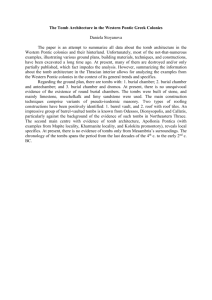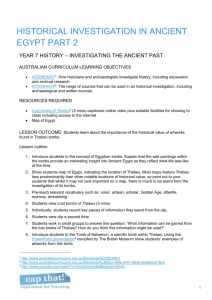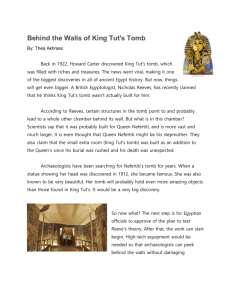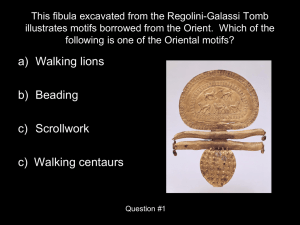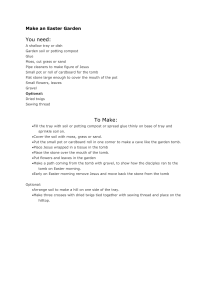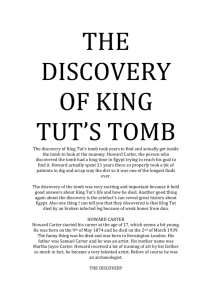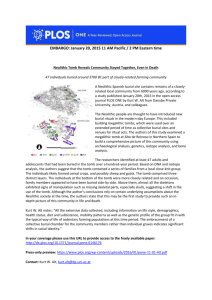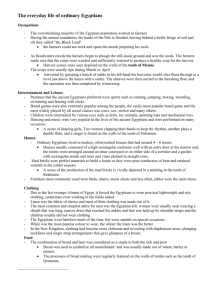0495094870_257848
advertisement
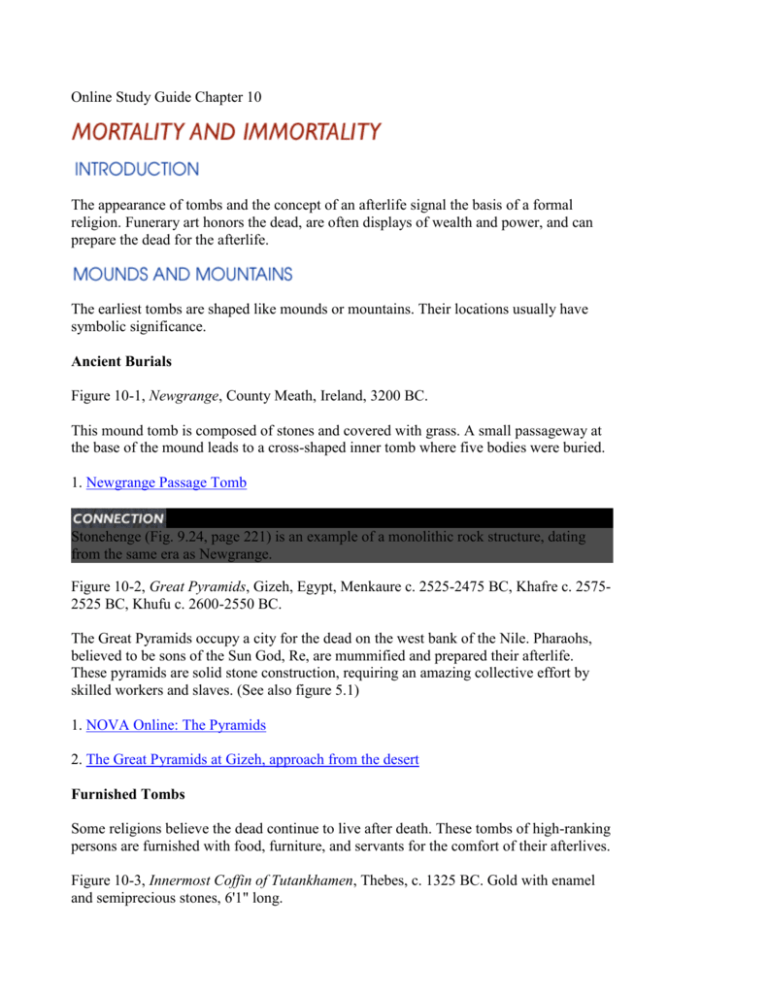
Online Study Guide Chapter 10 The appearance of tombs and the concept of an afterlife signal the basis of a formal religion. Funerary art honors the dead, are often displays of wealth and power, and can prepare the dead for the afterlife. The earliest tombs are shaped like mounds or mountains. Their locations usually have symbolic significance. Ancient Burials Figure 10-1, Newgrange, County Meath, Ireland, 3200 BC. This mound tomb is composed of stones and covered with grass. A small passageway at the base of the mound leads to a cross-shaped inner tomb where five bodies were buried. 1. Newgrange Passage Tomb Stonehenge (Fig. 9.24, page 221) is an example of a monolithic rock structure, dating from the same era as Newgrange. Figure 10-2, Great Pyramids, Gizeh, Egypt, Menkaure c. 2525-2475 BC, Khafre c. 25752525 BC, Khufu c. 2600-2550 BC. The Great Pyramids occupy a city for the dead on the west bank of the Nile. Pharaohs, believed to be sons of the Sun God, Re, are mummified and prepared their afterlife. These pyramids are solid stone construction, requiring an amazing collective effort by skilled workers and slaves. (See also figure 5.1) 1. NOVA Online: The Pyramids 2. The Great Pyramids at Gizeh, approach from the desert Furnished Tombs Some religions believe the dead continue to live after death. These tombs of high-ranking persons are furnished with food, furniture, and servants for the comfort of their afterlives. Figure 10-3, Innermost Coffin of Tutankhamen, Thebes, c. 1325 BC. Gold with enamel and semiprecious stones, 6'1" long. Tutankhamen's tomb is the only pharaoh's tomb to be discovered in modern times relatively intact. The innermost coffin is made of gold and jewels. The coffin includes a portrait of the pharaoh to serve as a substitute"body" for the returning spirit should something happen to the body. 1. Tutankhamen's Tomb Figure 10-4, Fowling Scene from the Tomb of Nebamun, Thebes, c. 1400-1350 BC. Paint on dry plaster, approx. 32" high. Paintings on tomb walls depict earthly pleasures. The relative size of the central figure and his stylized rendering indicate a person of high rank. 1. Fowling Scene, wall painting from Thebes Figure 10-5, Mortuary Temple of Hatshepsut, Deir el-Bahri, c. 14490-1460 BC. Hetshepsut's temple, carved into a cliff face, once included a large garden. Her successor pillaged the temple and destroyed all portraits of her after her death. 1. Mortuary Temple of Hatshepsut 2. Mortuary Temple of Hatshepsut Etruscan Tombs Figure 10-6, Sarcophagus with Reclining Couple, Cerveteri, Etruria (Italy) c. 520 BC. Painted terracotta, 45.5" tall. Etruscan mound graves were clustered in cities of the dead. Tombs recreated typical Etruscan homes. Despite a generalization of their features, the couple conveys an alertness, vigor, and happiness. 1. Estruscan Virtual Art Museum 2. Detail from the Sarcophagus Figure 10-7, Banqueters and Musicains from the Tomb of the Leopards, Tarquinia, Etruria (Italy) c. 480-470 BC. Funerary wall painting. The joys of life are emphasized in Etruscan tomb art. This painting depicts banqueters enjoying food and music. 1. Banqueters and Musicians from the Tomb of the Leopards, Tarquinia, Etruria c. 480470 BC Funeral Complex of Shi Huangdi Emperor Shi Huangdi unified China by eradicating his rivals, homoginizing Chinese culture, and initiating a series of monumental building projects like the Great Wall of China. He also built a sprawling funeral complex for himself that has been only partially excavated. Figure 10-8, Soldiers in Pit 1, near the tomb of Shi Huangdi, Shaanxi, China, c. 221-206 BC. Average figure height 5'9". An army of life-size terracotta soldiers guard the funeral palace. They were once painted and held weapons in their hands. 1. Soldiers from the tomb of Shi Huangdi, Shaanxi, China. Figure 10-9, Infantry General, painted ceramic, 6'4" tall, from the tomb of Shi Huangdi. While their bodies are simplified and were mass-produced, each terracotta head is individualized. This soldier is thought to be the army commander. 1. Shi Huangdi, Ruler of the Qin Dynasty 2. Cavalryman and horse from the tomb of Shi Huangdi Royal Tombs of the Moche Civilization The Moche was a thriving civilization, building temples, palaces, and adobe pyramids. Warrior priests most likely held the highest rank among Moche society. These warrior priests were responsible for ritual human sacrifices. Figure 10-10, Mannequin dressed in replica of some of the objects found in Tomb 1, Moche Civilization, Peru, c. 300. This mannequin displays a sample of the funeral garb found in the Royal Tomb of Sipan. 1. The Lord of Sipan, gold garments 2. Peruvian examples of gold and garments Figure 10-11, Peanut Necklace, Moche Civilization, Peru, c. 300. Gold and silver necklace from the Royal Tomb of Sipan, 20” diameter. Musdeo Archeologico Nacional Bruning de Lambayeque, Peru. 1. Warrior Ear Ornament, restored. From Royal Tomb at Sipan. Viking Ship Burial As maritime raiders in life, Viking tombs reflect their close relationship with the sea. Figure 10-12, Viking Ship, from Oseberg ship burial, Norway, early 9th century. Oak, 65 feet long. This Viking ship was discovered in a high-ranking woman's mound tomb. It contained two bodies, numerous art and utilitarian objects, and animal remains. 1. Viking Ship from the Oseberg ship burial During the first millennium BC, tombs began to be conceptualized as monuments to the dead rather than being dwellings for the dead. The ancient Greeks created some of the first elaborate mausolea exalting the powerful. Urban growth in Europe prompted the development of cemeteries catering to the middle class. Figure 10-13, Grave stele of Hegeso, from the Dipylon cemetery, Athens, Greece, c. 410400 BC. Marble, 5'2" high. Ancient Greek grave markers tend to depict quiet, domestic scenes. This relief originally had been painted. 1. Grave stele of Hegeso, from the Dipylon cemetery, Athens Figure 10-14, Funerary Relief of a Circus Official, Ostia, Italy, 110-130 AD. Marble, 20 inches high. The Romans considered funerary monuments expressions of family honor and status. This circus official holds hands with a woman standing on a pedestal, signaling that she was his dead wife. 1. Funerary Relief of a Circus Official Realistic portraiture was important because respected ancestors raised the status of the living Romans, as discussed in Art and History in Context, page 268. For an example of nonidealized Roman portraiture, see Statue of Togato Barberini (Fig. 14.12) Christian Burials Many early Christians were buried underneath churches in a system of tombs called catacombs. Chapels were built in the catacombs when Roman persecution forced services underground. Remains of Christian martyrs became highly sought-after fetish objects. Figure 10-15, Ceiling painting from the Catacomb of Sts. Peter and Marcellinus, Rome, early 4th century. Mortuary chapels were often painted with uplifting Christian and pastoral themes. Backgrounds were white to counter the darkness of the windowless chapels. 1. Fresco from Catacomb of Commodilla of Maria Regina and Child and SS. Felix and Damian, 6th c. (Rome). Figure 10-16, Baldacchino, Gianlorenzo Bernini, St. Peter's Rome, Italy, 1624-1633. Gilded bronze, 100 feet high. An ornate canopy called a Baldacchino marks the site of St. Peter's tomb. Its design recalls the cloth canopies once used to cover early Christian martyrs. 1. Baldacchino Later Christian art became much more formalized, rigid in design and aweinspiring in Figure 10-17, Chapel of Henry VII, Westminster Abby, England, 1503-19. size, as seen in the detail of the Deesis Mosaic from Hagia Sophia in Istanbul (Fig. 2.15). Henry VII paid to have a separate chapel built for him and his wife at Westminster Abbey in London. It is built in English Perpendicular style, a variation on the Gothic style. 1. The Lady Chapel Compare the French Gothic cathedral emphasis on verticality with the elaborate Perpendicular style of the Chapel of Henry VII. See Chartres Cathedral, Figures 9.36 and 9.37, page 233. Islamic Mausolea Wealthy Muslims were sometimes buried in mausolea adjoining mosques. In the manuscript painting Babur Supervising the Layout of the Garden of Fidelity Figure 10-18, Taj Mahal, Agra, India. 1632-1654. (Figure 15.15, page 413), we see an example of a walled garden from Persia. The Taj Mahal was built by Shah Jahan for his wife Mumtaz Mahal. The mausoeum sits 1. Gardens of the Mughal Empire at the north end of a garden, and symbolizes the throne of God in the garden of Paradise. 1. Explore the Taj Mahal, Agra, India 2. Another view of the Taj Mahal 3. Exterior detail of the Taj Mahal 4. Detail of a carved wall from the Taj Mahal 5. Interior detail, inlaid and carved marble Body parts and possessions belonging to deceased holy persons are sometime separated from the corpse and kept in small shrines called reliquaries. Figure 10-19, Reliquary Arm. Silver over oak; hand: bronze-gilt; appliqué plaques: silvergilt, niello, and cabochon stones; 25 ½" x 6 ½" x 4". Mosan (Belgium), c. 1230. The Cloisters Collection, 1947. Medieval Christian churches sought to attract pilgrims by acquiring body parts or pieces of clothing from saints. Reliquaries often had sculptural representations of the body part contained within. 1. Examine a variety of silver and gold reliquaries at this site 2. Bust Reliquary of St. Benedict 3. 14th century gold and jewel encrusted reliquary Figure 10-20, Reliquary Guardian Figure, Gabon, Africa. Wood, brass, 24" high. This reliquary sculpture was placed in a bag or basket containing ancestral long bones. The figure embodied the spirits of dead ancestors and was used in ceremonial performances. 1. Reliquary figure from Gabon Modern Cemeteries Churches in cities ran out of room during the Industrial Revolution. European governments authorized the construction of suburban, nondenominational cemeteries. Figure 10-21, Père Lachaise Cemetery, Paris, France, opened 1804. The Père Lachaise Cemetery was influenced by the Romantic movement, which emphasized pastoral simplicity. Owners of funeral plots could mark graves any way they wished, resulting in a very eclectic mix of monuments. 1. Walkway at Pere Lachaise Cemetery in Paris 2. Pere Lachaise Cemetery Figure 10-22, Ophelia, John Everett Millais, England, 1852. Oil on canvas, 30" x 44". Romantic art like Millais' Ophelia emphasizes the beauty of nature and a lyrical view of death. 1. John Everett Millais, Ophelia, 1852, Tate Gallery, London. 2. Millais' Study for Ophelia Contemporary Memorial Art and Practices Memorial art serves social and political functions. Figure 10-23, Dia de Los Muertos, Diego Rivera, fresco, south wall, Court of Fiestas, Ministry of Education, Mexico City, 1923. Rivera was commissioned by the Mexican government to paint a mural on Day of the Dead festivities. We can see from the crowds of people and the skeletons playing instruments that a day dedicated to death is a very lively affair. 1. Detail from Rivera's Dream of a Sunday Afternoon in Alameda Park 2. View images from the Patio of Fiestas, third wall Figure 10-24, Helmet Mask (Tatanua), Oceania, 19th century. Northern New Ireland, Papua New Guinea. Wood, paint, natural fibers, and opercula shells. 15 ¼” x 9 ½” x 12”. 1. Malagan and Other New Ireland Art Figure 10-25, Mausoleum of Mao Zedong, Tienamen Square, Beijing, China. Late 20th century. The tomb of the communist leader is located in the middle of Tienamen Square, which faces the Forbidden City. The location of Mao's mausoleum seeks to affirm his regime as the legitimate successor to China's imperial line. 1. Tiananmen Square, with Mausoleum of Mao Zedong See the discussion of the elaborate Forbidden City and the elaborate Forbiden City and the Imperial Throne Room in the Hall of Supreme Harmony in Chapter 11. (Fig. 11.11). Like the tomb of Mao Zedong, the Vietnam Veterans Memorial (Figure 11.3, page Figure 10-26, AIDS Memorial Quilt, displayed on the Mall in Washington DC, October 328) stands on politically significant ground, the Mall in Washington, D.C. 11, 1996. 1. Vietnam Veterans' Memorial, Washington, D.C. The Quilt is composed of individualized panels memorializing people who have died of AIDS. Seen in its entirety or more often, in sections, the Quilt changes each time it is displayed. 1. Details of the Aids Quilt in Washington, D.C. 2. Aids Memorial Quilt Figure 10-27, John Bennett, Gustavo Bonevardi, Richard Nash Gould, Paul Myoda, Julian LaVerdiere, and Paul Marantz. Tribute in Light. High-power lamps. World Trade Center Memorial at Ground Zero, New York City, 2002. 1. Tribute in Light Figure 10-28, Studio Daniel Libeskind. Computer-Generated Design to Rebuild the World Trade Center Site. Selected design for World Trade Center Site Memorial – Reflecting Absence by Michael Arad and Peter Walker, Copyright 2004 LMDC. 1. Daniel Libeskind WTC Plan 2. WTC Memorial Competion
